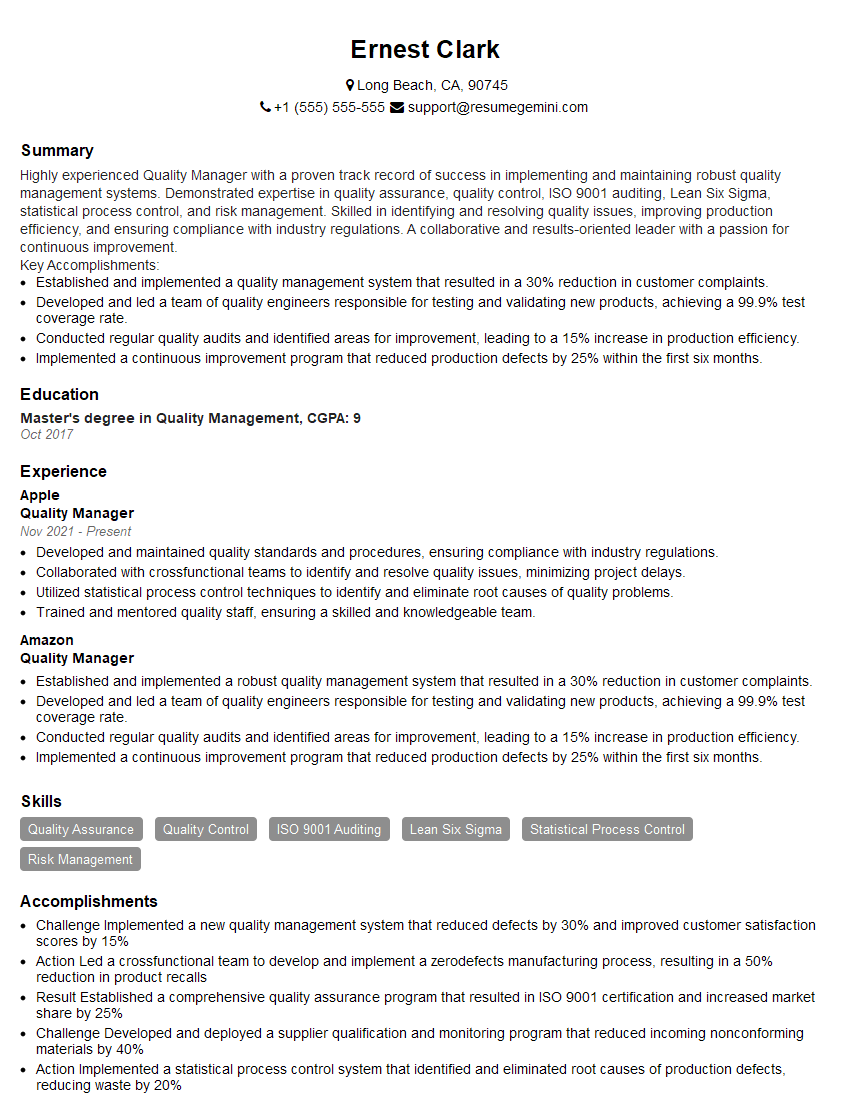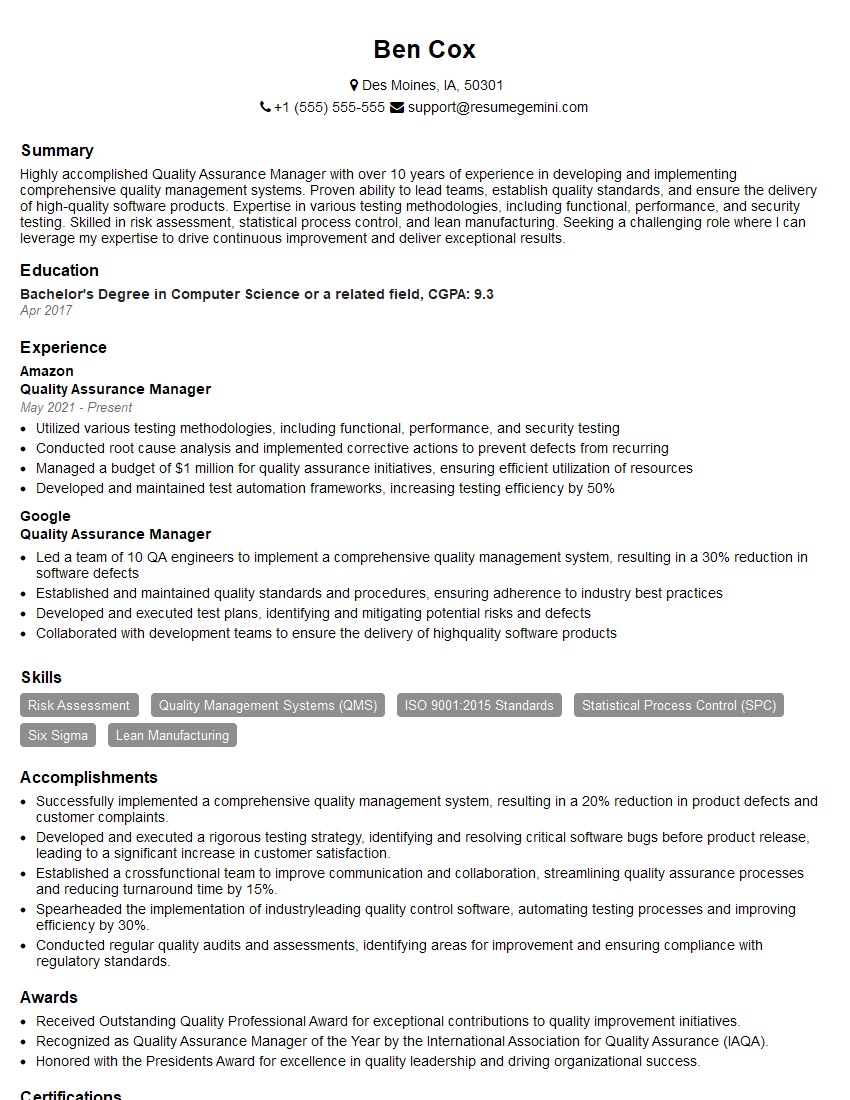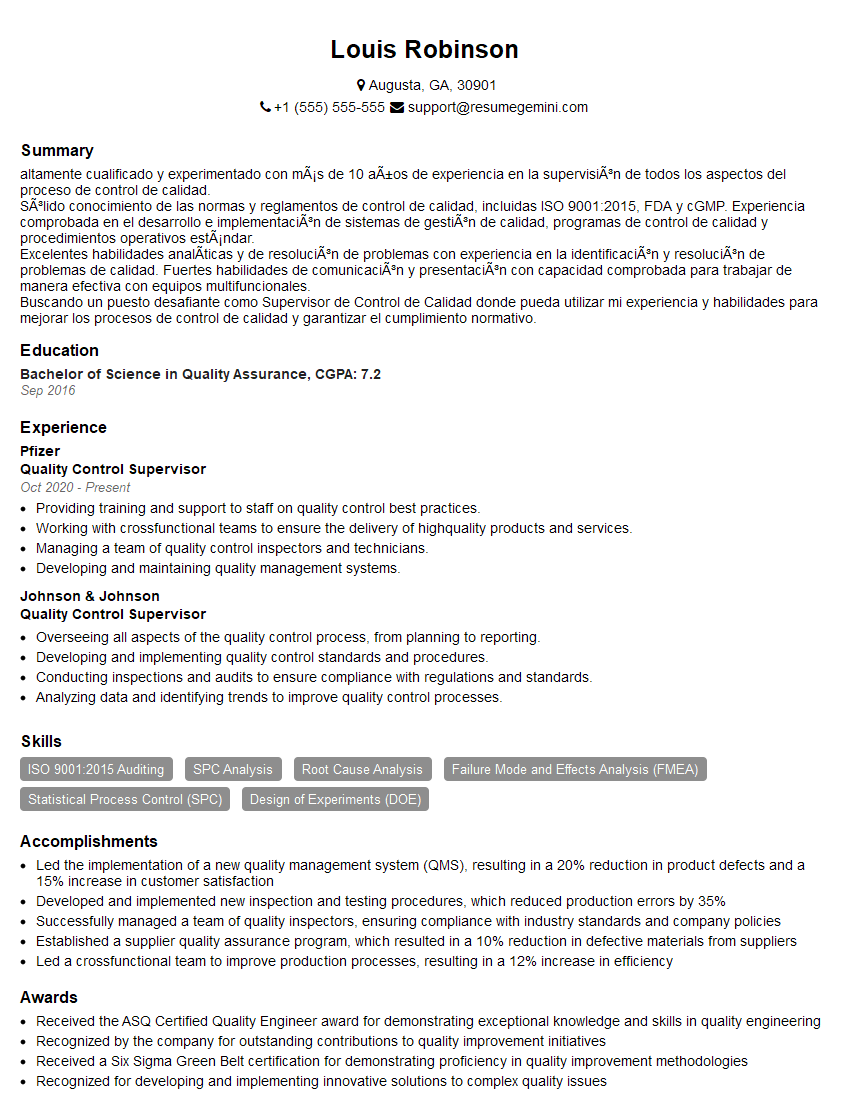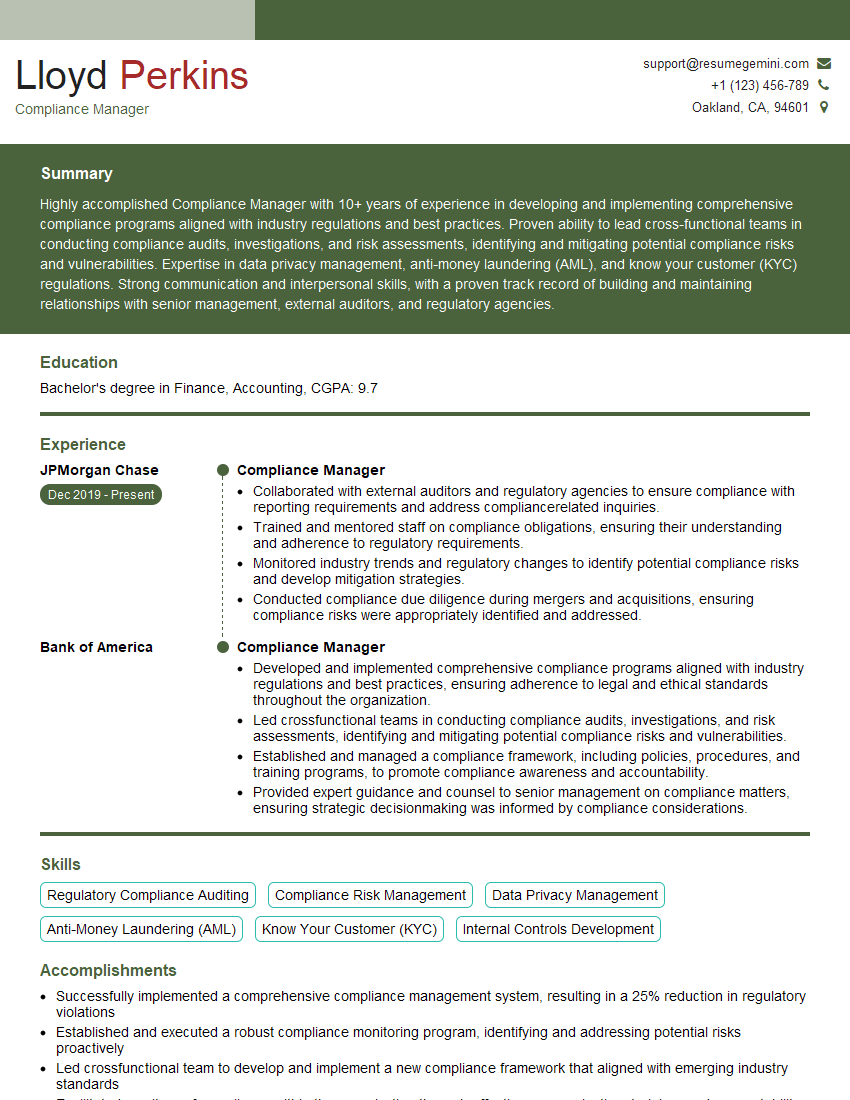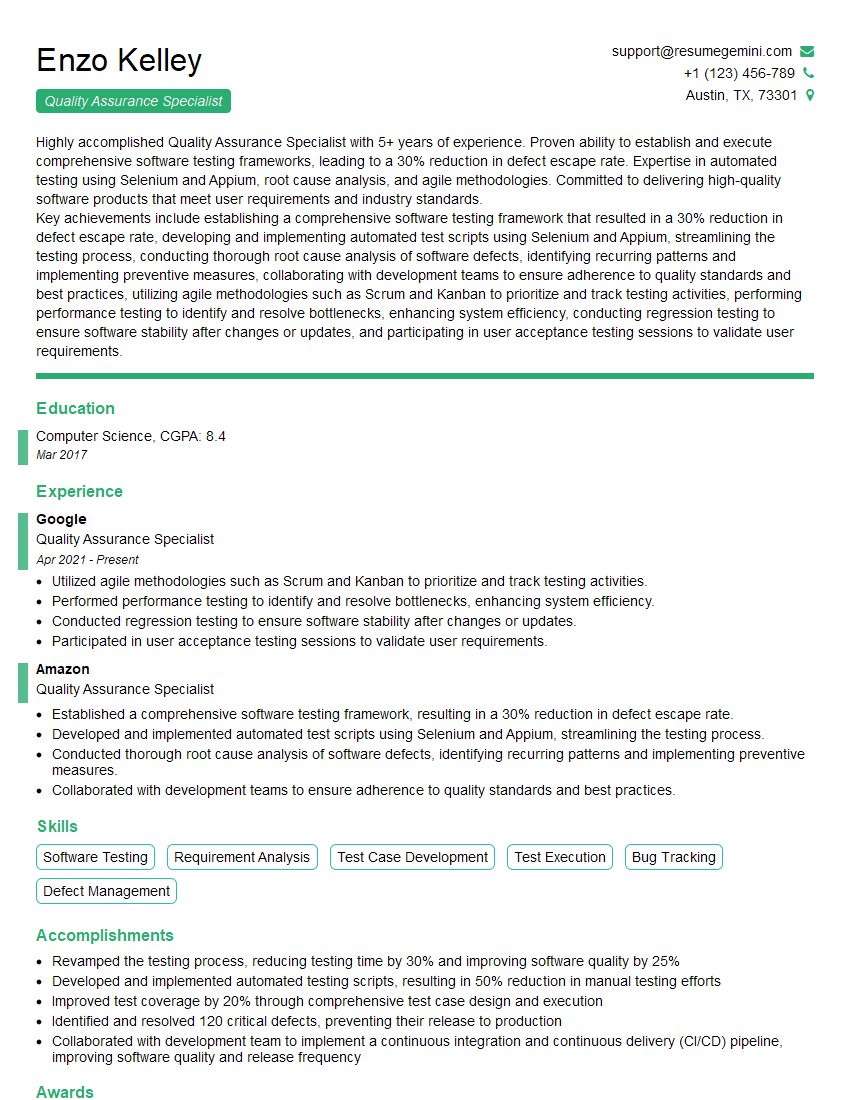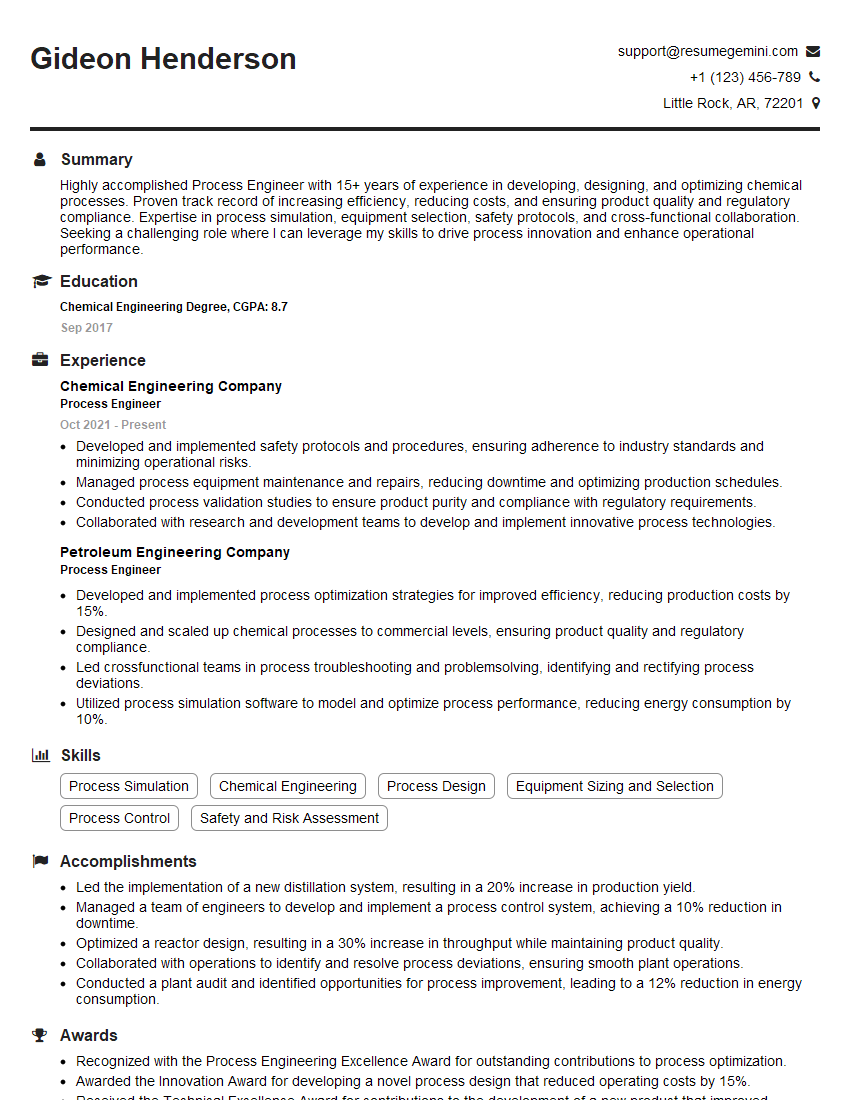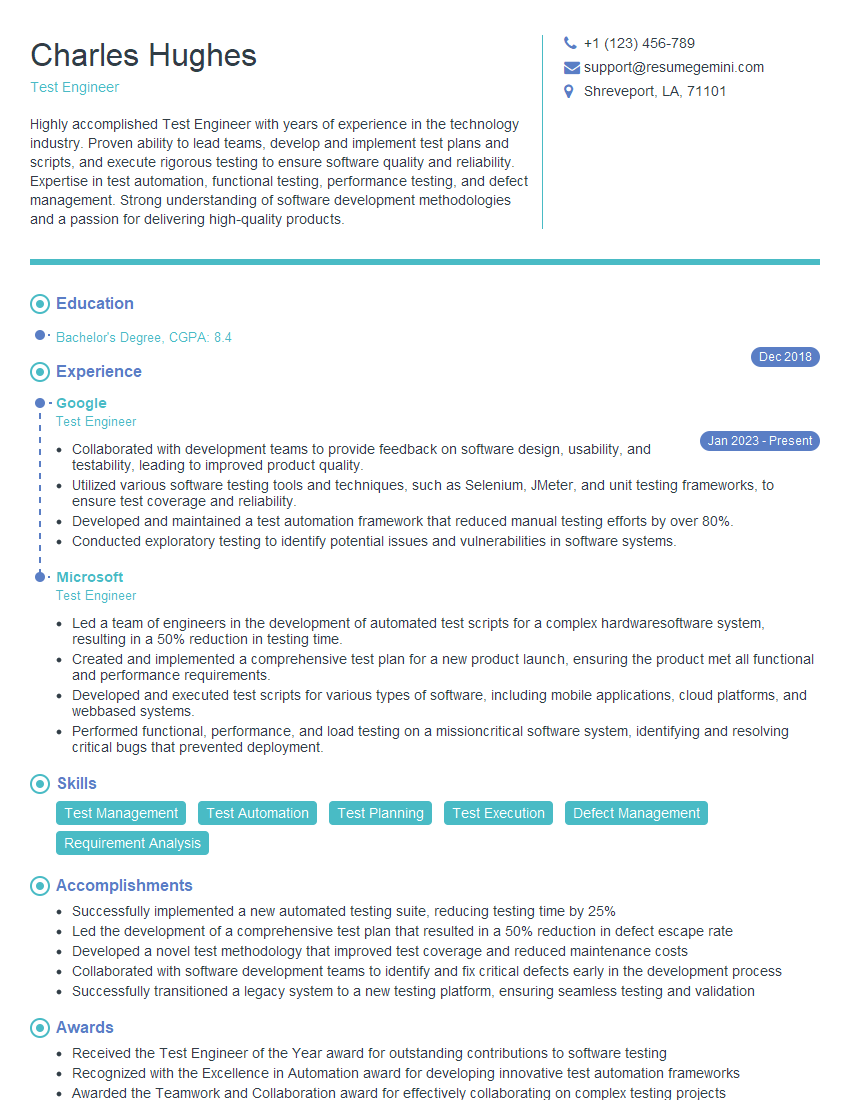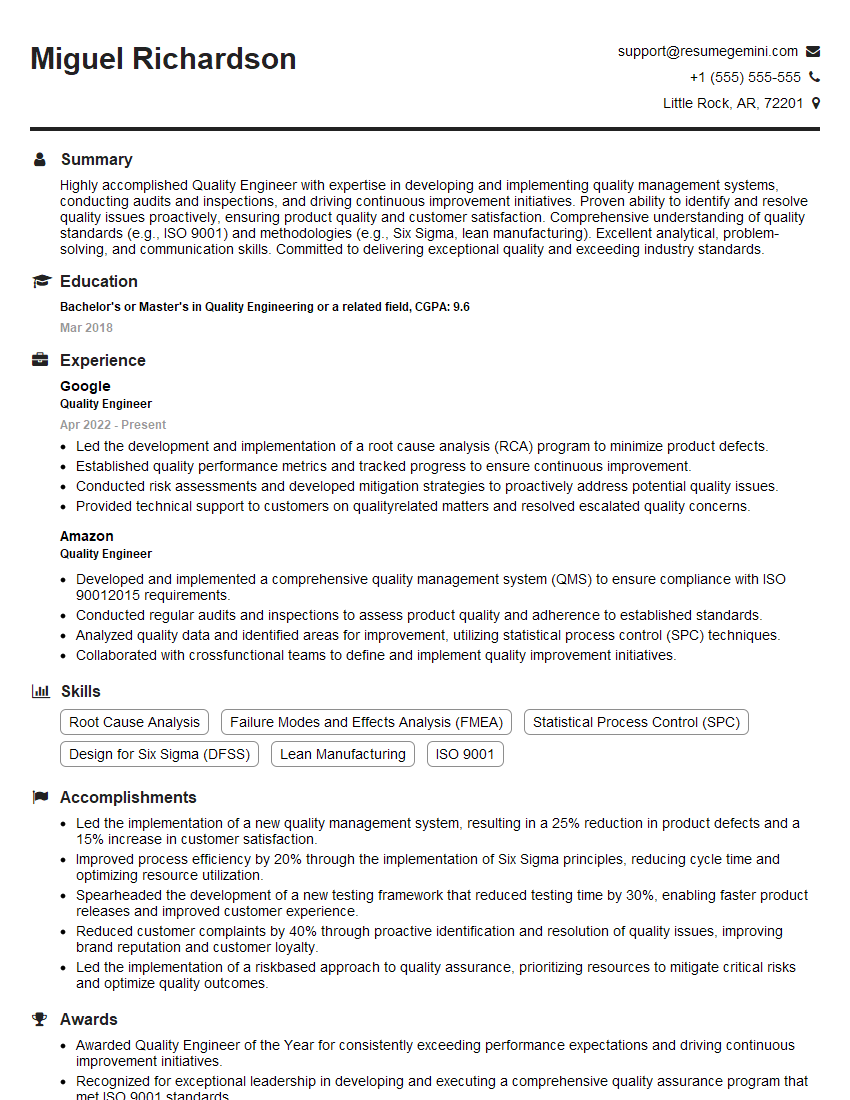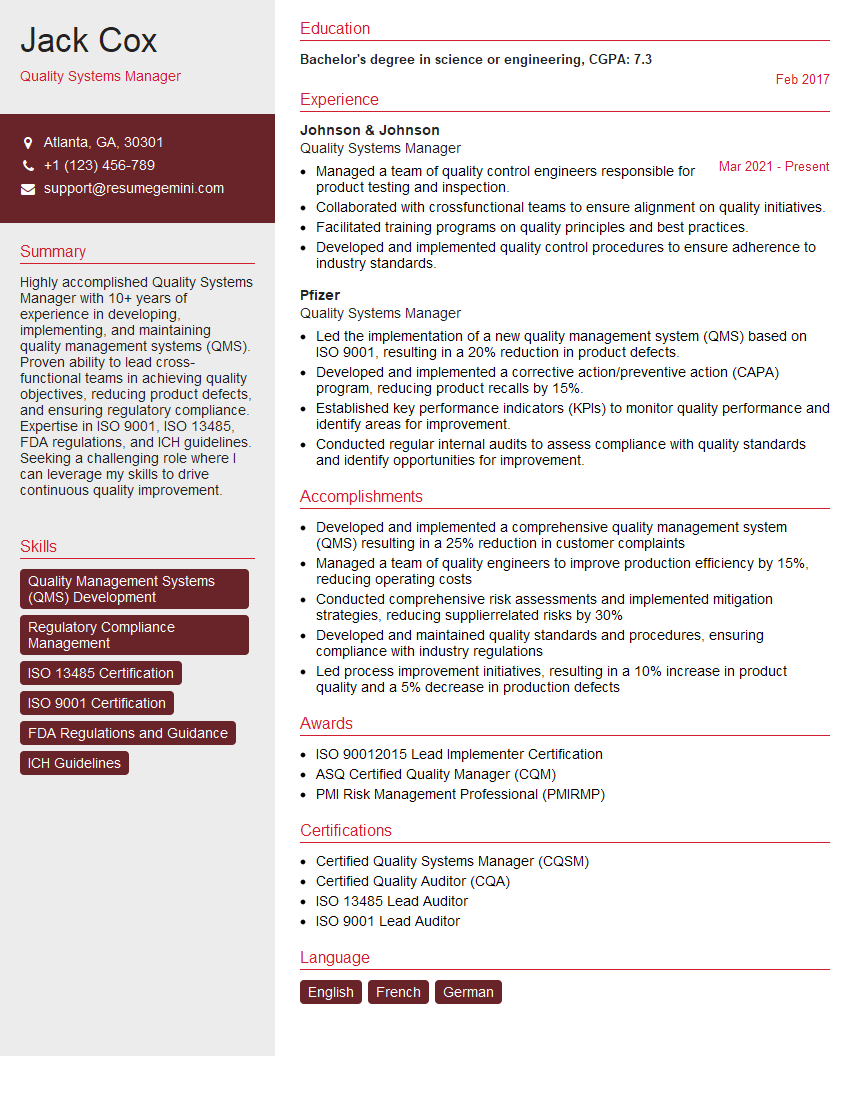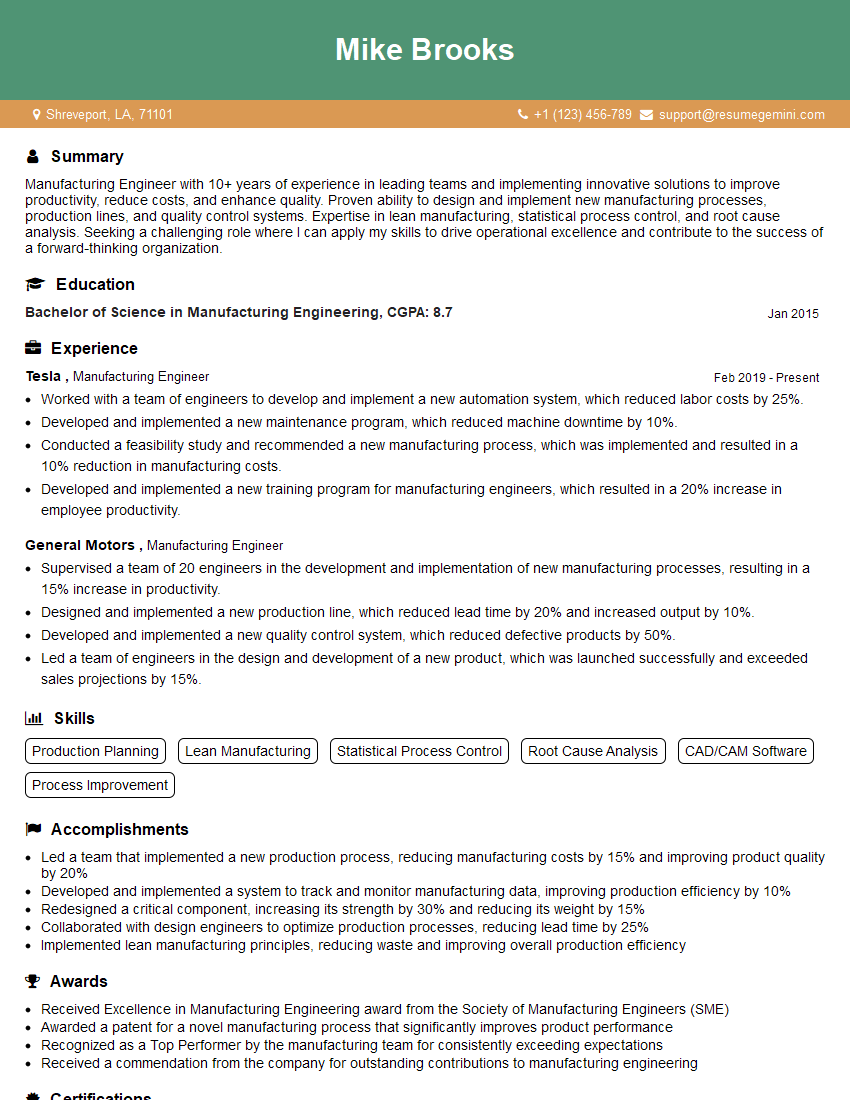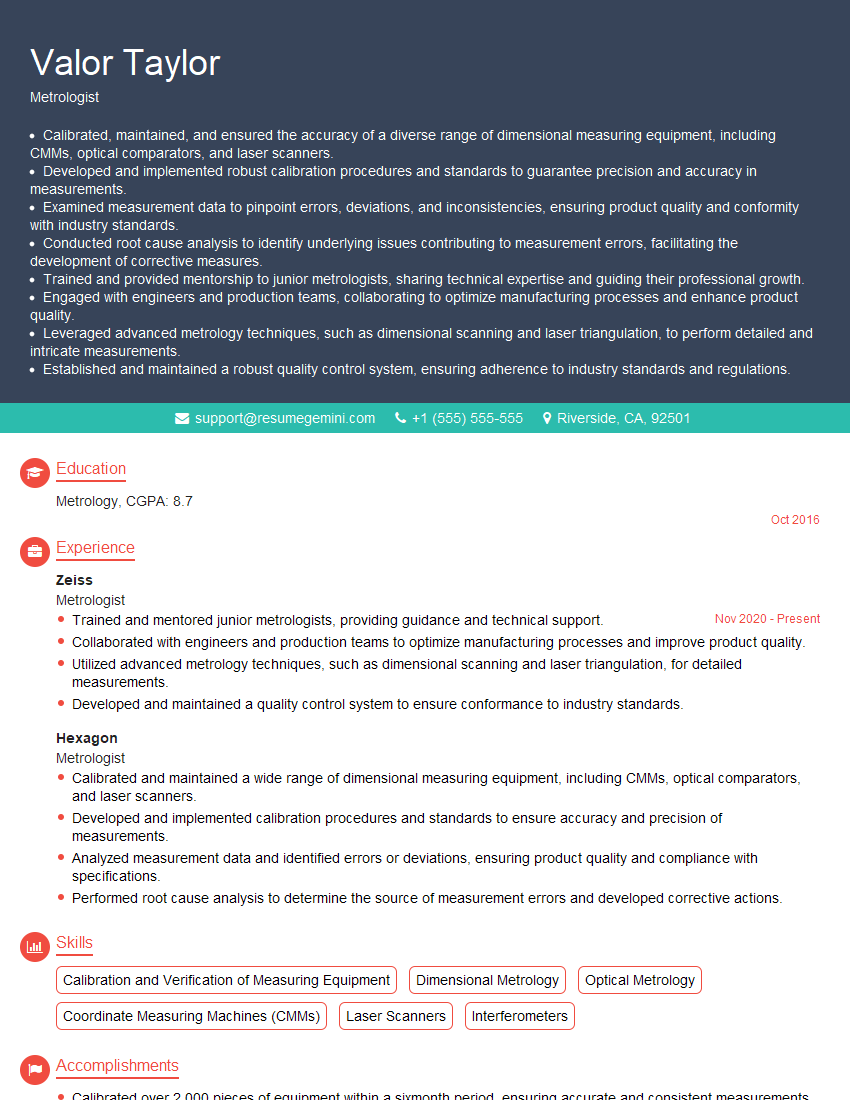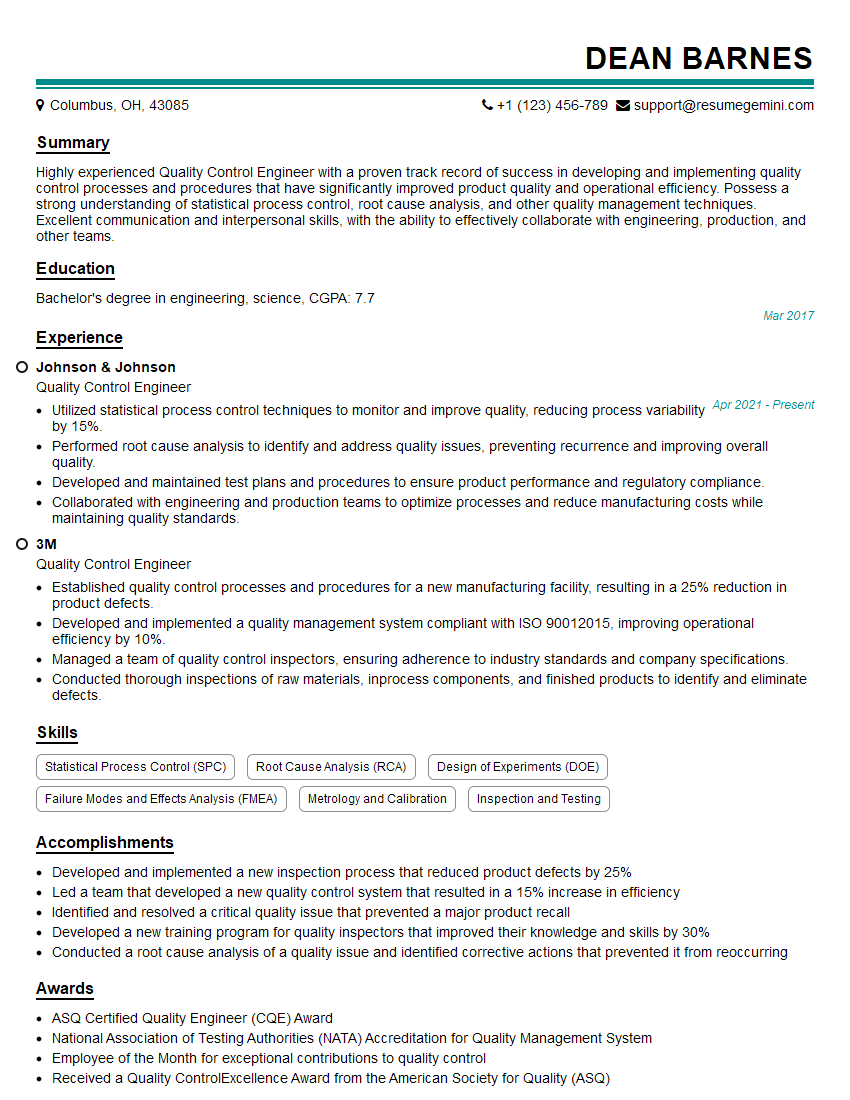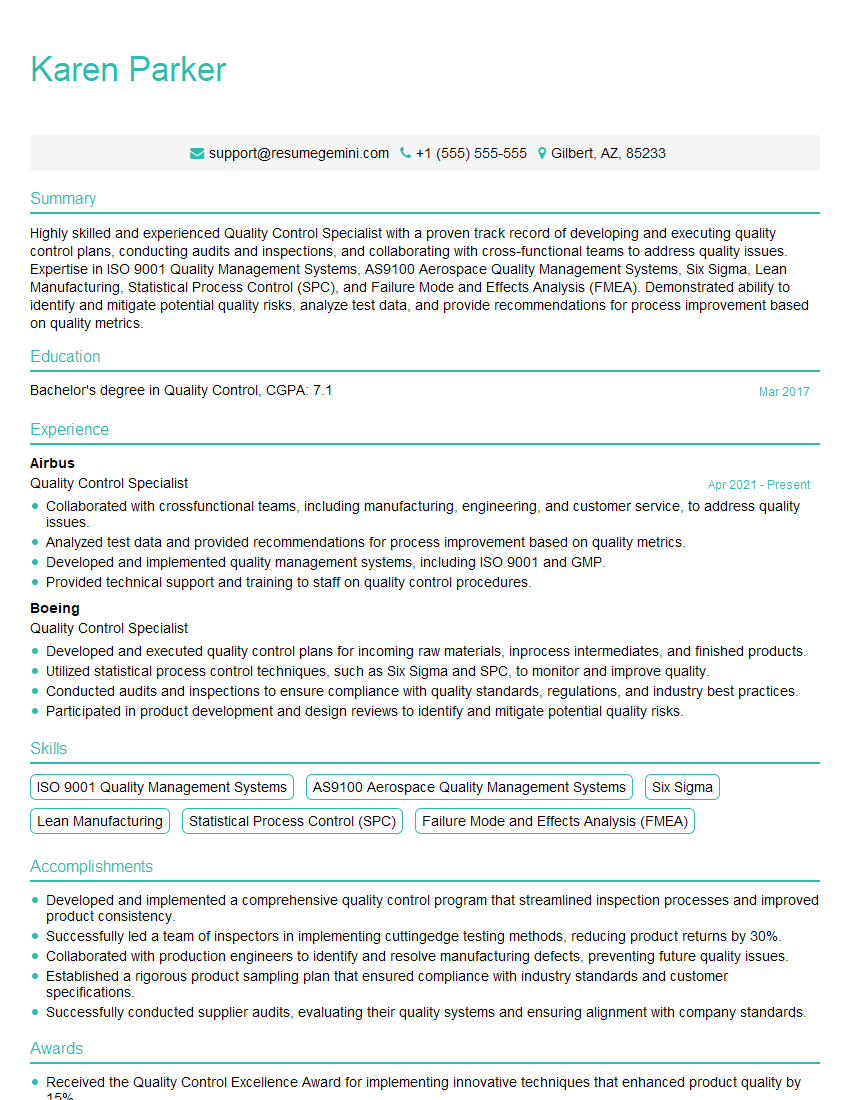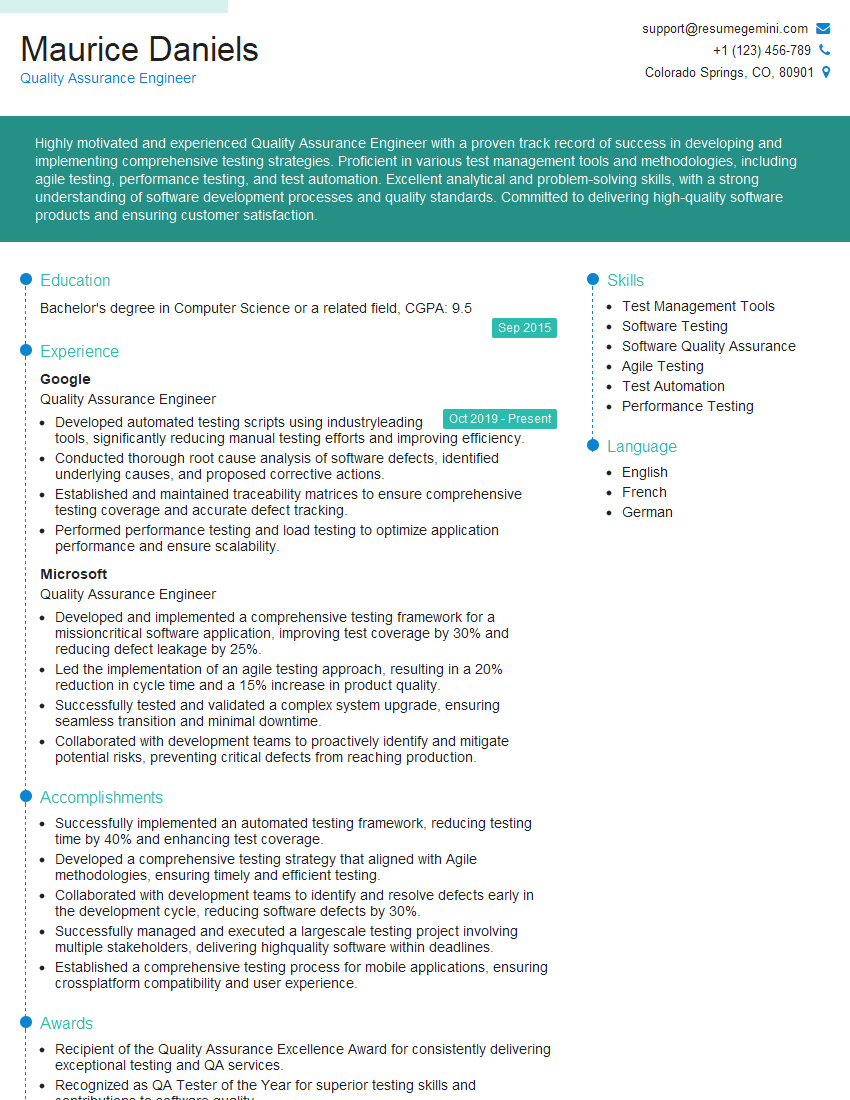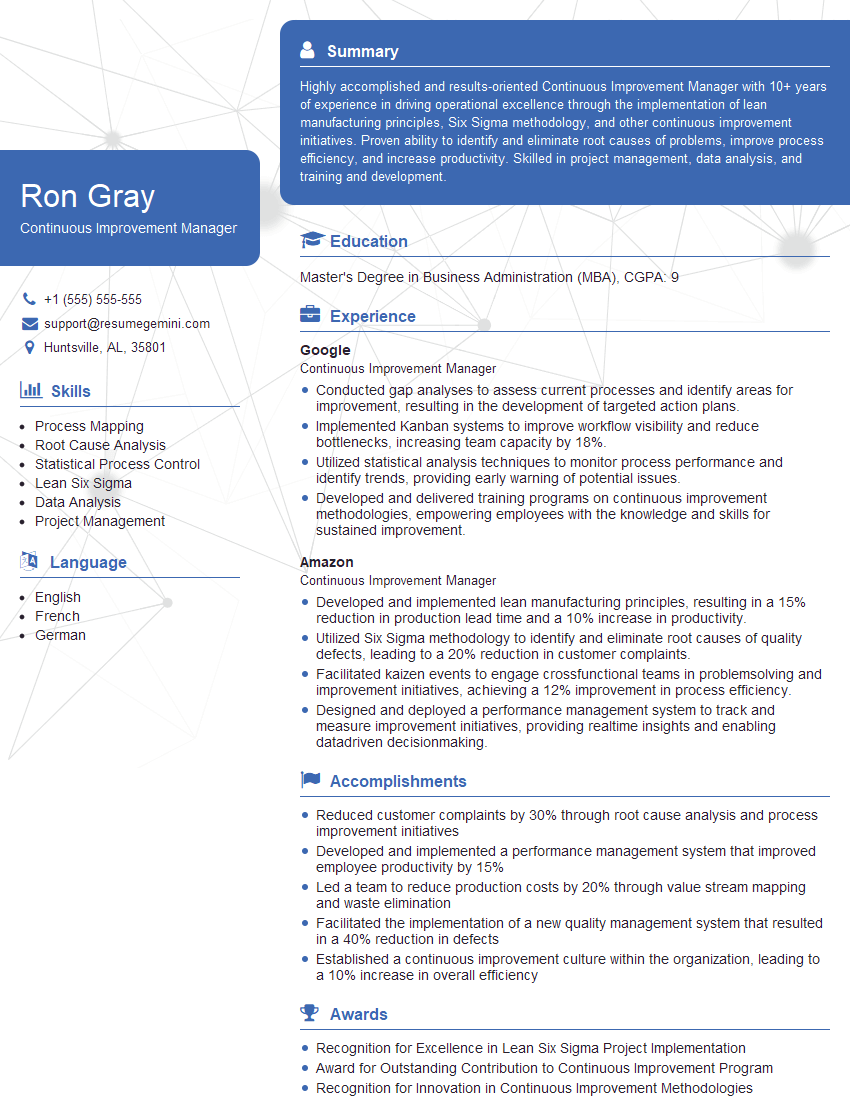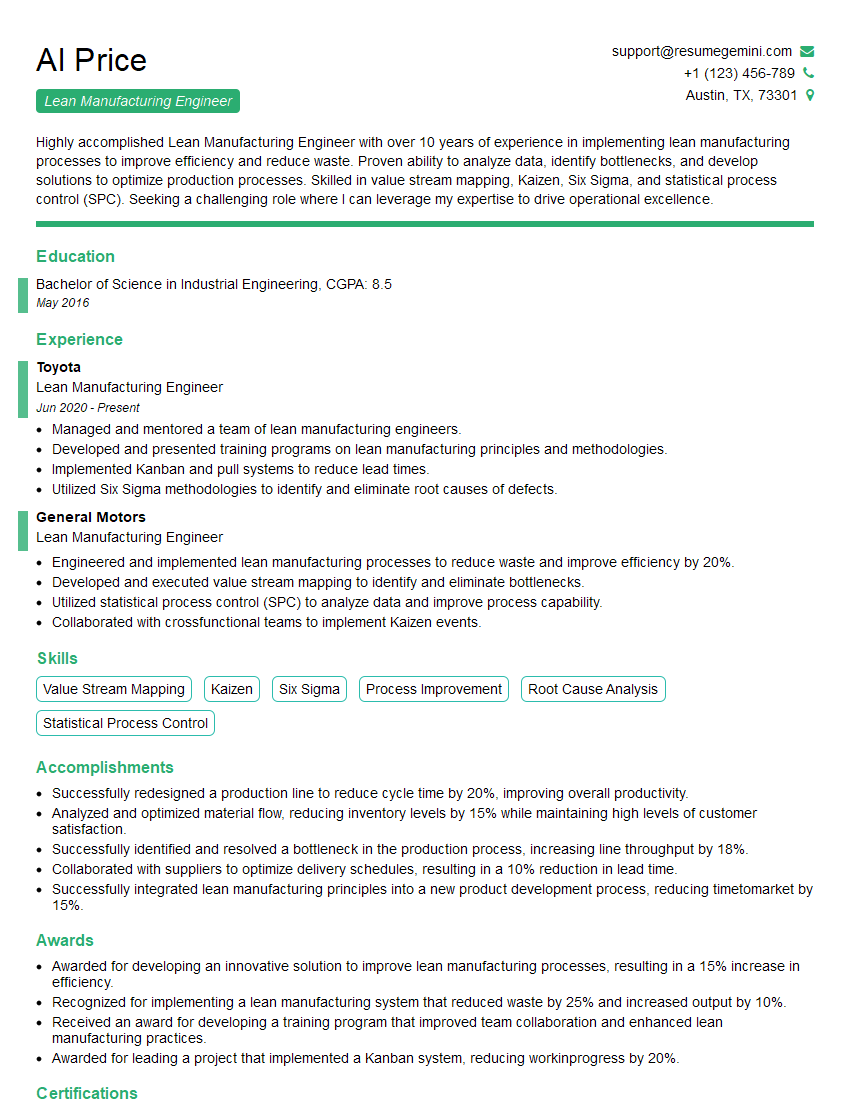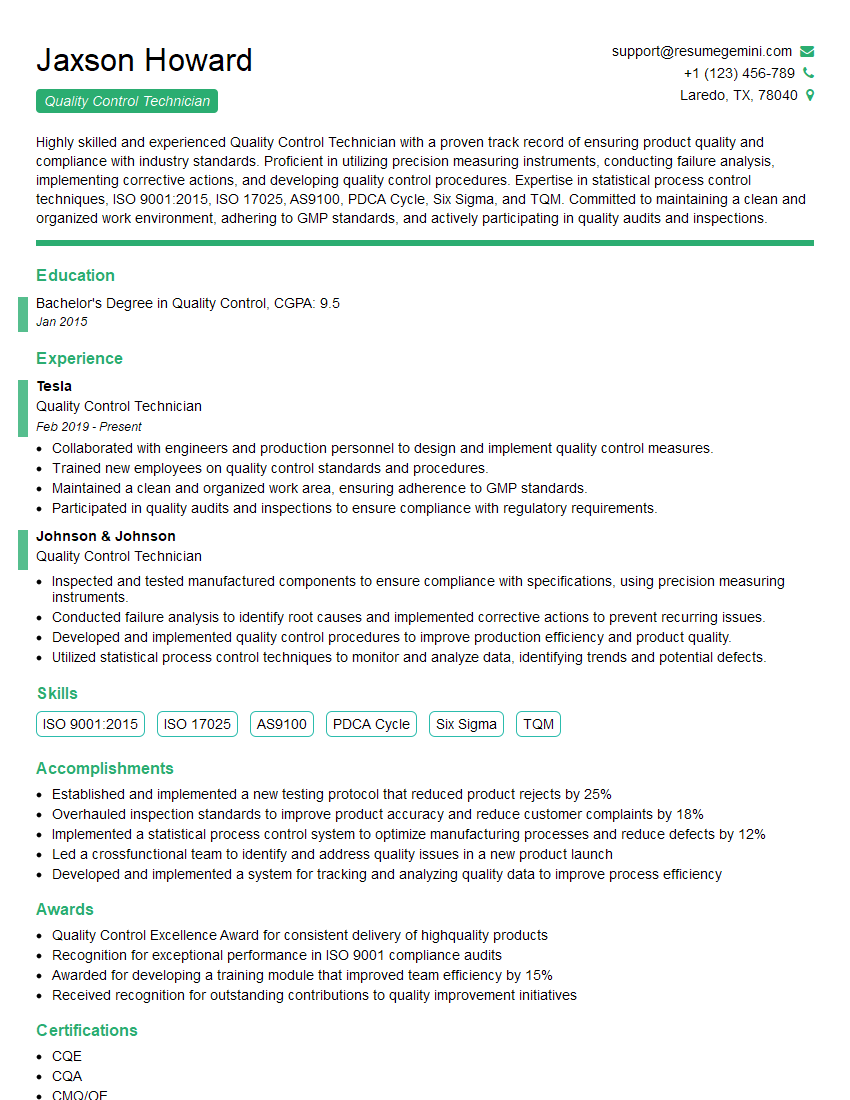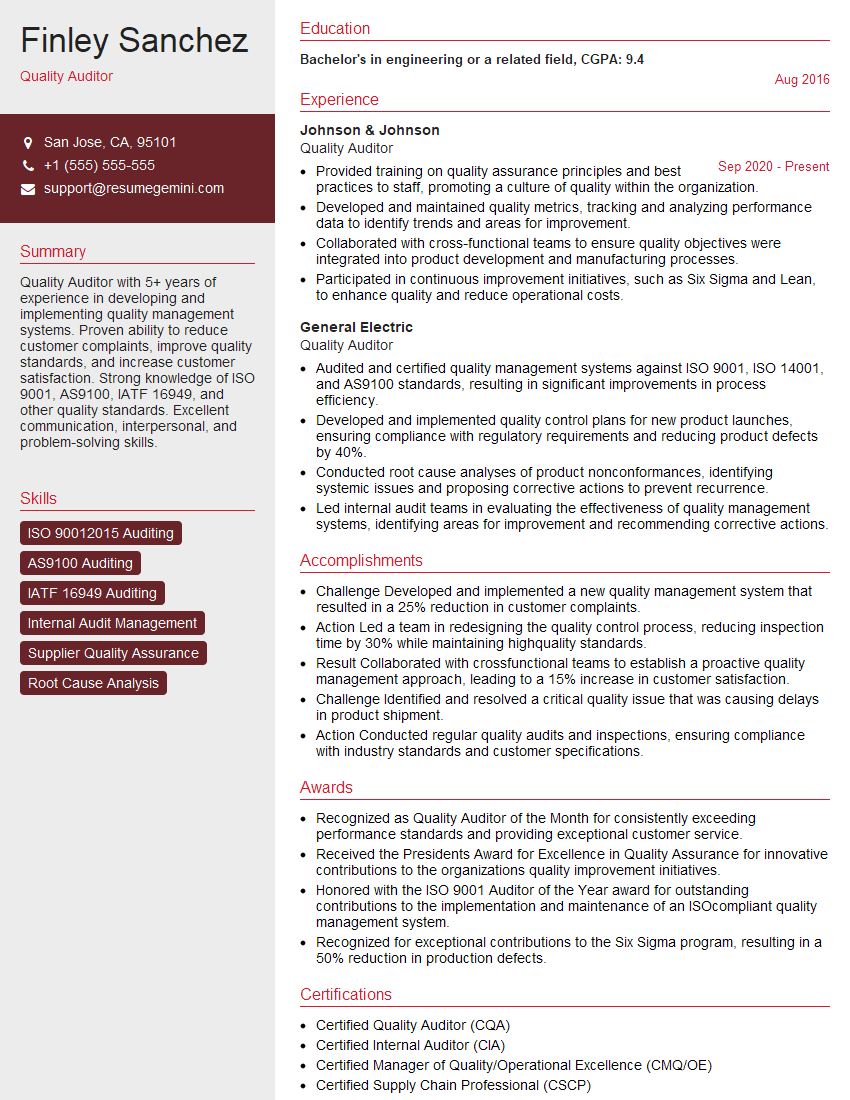Interviews are more than just a Q&A session—they’re a chance to prove your worth. This blog dives into essential ASQ CQE Certification interview questions and expert tips to help you align your answers with what hiring managers are looking for. Start preparing to shine!
Questions Asked in ASQ CQE Certification Interview
Q 1. Explain the key differences between Quality Control and Quality Assurance.
Quality Control (QC) and Quality Assurance (QA) are often confused, but they represent distinct yet complementary approaches to quality management. Think of QA as setting the stage for quality, while QC verifies that the play is performed as planned.
Quality Assurance (QA): Focuses on preventing defects. It’s a proactive process that involves planning, designing, and implementing systems to ensure a product or service meets specified requirements. This includes establishing procedures, training employees, and setting up quality standards. It’s about building quality into the process from the start.
Quality Control (QC): Focuses on identifying and correcting defects. It’s a reactive process that involves inspecting products or services to ensure they conform to predefined specifications. This includes testing, sampling, and implementing corrective actions when defects are found. It’s about checking the quality of the output.
Example: In a manufacturing plant producing widgets, QA would involve designing the manufacturing process to minimize widget defects (e.g., using better materials, improved machinery, better employee training). QC would involve inspecting finished widgets to identify and remove any defective ones before shipment.
Q 2. Describe your experience with various quality tools, such as Pareto charts, control charts, and fishbone diagrams.
I have extensive experience utilizing various quality tools. My proficiency lies in their practical application to solve real-world quality issues.
Pareto Charts: I use these to identify the vital few causes contributing to the majority of problems. For instance, in analyzing customer complaints about a software product, a Pareto chart would visually highlight the top three issues (e.g., slow loading speed, software bugs, and poor user interface) that account for 80% of the complaints, allowing us to prioritize our corrective actions.
Control Charts: I leverage these for monitoring process stability and identifying special cause variation. In a production line manufacturing bolts, I’d use control charts (like X-bar and R charts) to track the diameter of the bolts. Any point outside the control limits would signal a need for investigation and corrective action, preventing further production of non-conforming bolts.
Fishbone Diagrams (Ishikawa Diagrams): These are invaluable for brainstorming and identifying potential root causes of a problem. In a case where customer returns of a product increased dramatically, a fishbone diagram would allow us to systematically explore potential causes, categorized by factors like materials, manpower, machinery, methods, measurement, and environment.
Q 3. How would you implement a quality management system based on ISO 9001?
Implementing an ISO 9001-based Quality Management System (QMS) requires a structured approach. It’s not just about ticking boxes; it’s about embedding a culture of continuous improvement.
Top Management Commitment: Secure buy-in from leadership, emphasizing the benefits and allocating the necessary resources.
Gap Analysis: Conduct a thorough assessment of the current state of the organization against the ISO 9001 requirements, identifying areas for improvement.
Develop a Quality Manual: Create a comprehensive document outlining the organization’s QMS, including policies, procedures, and responsibilities.
Implement Processes: Develop and implement processes for key areas, such as purchasing, production, and customer service, ensuring they align with ISO 9001 requirements and are documented.
Training and Awareness: Provide training to all employees on the QMS, their roles and responsibilities, and the importance of quality.
Internal Audits: Conduct regular internal audits to verify the effectiveness of the QMS and identify any areas for improvement.
Management Review: Conduct periodic management reviews to assess the performance of the QMS and make necessary adjustments.
Continuous Improvement: Embrace a culture of continuous improvement, leveraging tools like PDCA (Plan-Do-Check-Act) to address identified non-conformances and opportunities for improvement.
The entire process should focus on customer satisfaction and achieving consistent product or service quality. It’s a journey, not a destination.
Q 4. Explain the concept of statistical process control (SPC) and its applications.
Statistical Process Control (SPC) is a powerful method for monitoring and controlling processes to minimize variability and improve quality. It involves using statistical techniques to analyze process data and identify patterns that indicate potential problems.
Key Concepts:
Control Charts: Visual tools that plot process data over time, displaying upper and lower control limits. Points outside these limits signal potential process instability.
Common Cause Variation: Natural, inherent variation in a process. It’s always present and predictable.
Special Cause Variation: Variation caused by factors outside the normal process. It’s unpredictable and indicates a need for investigation and corrective action.
Applications: SPC is used in diverse industries, including manufacturing, healthcare, and finance. For example, in a pharmaceutical company, SPC can monitor the weight of tablets to ensure consistency and prevent the production of under or over-weight tablets. In a call center, SPC can track call handling times to identify areas for improvement in service delivery.
Q 5. Describe your experience with root cause analysis techniques.
My experience includes utilizing several root cause analysis techniques, selecting the most appropriate method depending on the situation. These techniques help to move beyond merely addressing symptoms to solving underlying problems.
5 Whys: A simple yet effective method involving repeatedly asking ‘why’ to drill down to the root cause. This is suitable for simple problems.
Fishbone Diagram: Useful for brainstorming and visually representing potential causes categorized by different factors (see previous answer).
Fault Tree Analysis (FTA): A more complex technique for analyzing failures, often used in critical systems where identifying potential failure points is vital.
Failure Mode and Effects Analysis (FMEA): Proactive technique to identify potential failures and their effects, allowing for preventative measures.
Example: If a machine keeps malfunctioning, the 5 Whys might reveal that the root cause is insufficient lubrication due to a faulty maintenance schedule.
Q 6. How would you develop and implement a corrective action plan?
Developing and implementing a corrective action plan (CAPA) is a crucial step in addressing identified non-conformances. A well-defined CAPA ensures issues are resolved effectively and prevent recurrence.
Identify the Problem: Clearly define the non-conformance or defect, documenting details such as date, location, and affected items.
Conduct Root Cause Analysis: Use appropriate techniques (as mentioned above) to determine the underlying cause of the problem.
Develop Corrective Actions: Propose specific actions to eliminate the root cause, making sure they are verifiable and measurable.
Implement Corrective Actions: Execute the planned actions, ensuring appropriate resources and timelines are allocated.
Verify Effectiveness: Monitor the implemented actions to verify their effectiveness in resolving the problem and preventing recurrence.
Document Everything: Maintain detailed records of the entire CAPA process, including root cause analysis, corrective actions, verification, and any follow-up actions.
Example: If customer complaints about late deliveries increase, a CAPA might involve improving the logistics process, providing better training to dispatch staff, and investing in real-time tracking systems.
Q 7. What are the key elements of a successful quality audit?
A successful quality audit hinges on several key elements, focusing on objectivity, thoroughness, and constructive feedback.
Planning: Defining the scope, objectives, and criteria of the audit, including the selection of audit team members and the scheduling of audits.
Preparation: Reviewing relevant documentation, gathering evidence, and creating an audit checklist.
Execution: Conducting the audit systematically and objectively, gathering data and evidence from interviews, document reviews, and observations. This includes following audit procedures and ensuring adherence to professional standards.
Reporting: Preparing a clear, concise, and unbiased report, documenting findings, including both non-conformances and areas of strength. The report should provide specific and actionable recommendations for improvement.
Follow-up: Monitoring the implementation of corrective actions and verifying their effectiveness.
The whole process needs to be fair, impartial, and focused on continuous improvement. It’s not about finding fault but about enhancing the quality management system.
Q 8. Explain your understanding of process capability analysis (Cpk, Ppk).
Process capability analysis assesses whether a process can consistently produce output within pre-defined specifications. Cpk (Process Capability Index) and Ppk (Process Performance Index) are key metrics used. Cpk measures the process capability relative to the short-term variation, assuming the process is stable. Ppk considers the total variation over a longer period, encompassing both short-term and long-term variability. A higher Cpk/Ppk value (ideally above 1.33) indicates a more capable process.
Cpk focuses on the process’s inherent variability when it’s operating in a controlled state. Imagine a machine filling bottles: Cpk assesses how consistently it fills them to the target amount when running smoothly. Ppk, on the other hand, accounts for all variations, including those caused by shifts, changes in materials, or operator differences. Think of the same bottle-filling machine across different shifts: Ppk reflects the overall consistency, incorporating variations due to operator differences or material fluctuations.
Calculating Cpk and Ppk: Both indices utilize the mean (x̄), standard deviation (σ), upper specification limit (USL), and lower specification limit (LSL). The formulas involve the minimum of (USL – x̄) / 3σ and (x̄ – LSL) / 3σ for Cpk and a similar calculation using the overall standard deviation for Ppk. Statistical software makes this straightforward.
Practical Application: In manufacturing, Cpk/Ppk analysis guides process improvement initiatives. A low Cpk suggests the need for machine adjustments, operator training, or material quality improvements. A low Ppk points to inconsistencies that require a more comprehensive investigation, potentially involving process control improvements or different control charts.
Q 9. How do you handle conflict resolution in a team environment during a quality issue?
Conflict resolution during quality issues requires a collaborative, structured approach. My strategy focuses on:
- Active Listening: I ensure everyone feels heard and understood, focusing on the problem rather than personalities.
- Factual Data: We ground discussions in data and evidence, avoiding emotional responses. Control charts, Pareto diagrams, or other relevant quality tools are used to illuminate the core issue.
- Root Cause Analysis: We collaboratively use tools like the 5 Whys or fishbone diagrams to uncover the root cause of the problem, not just surface-level symptoms.
- Brainstorming Solutions: A collaborative brainstorming session generates various solutions, considering the input from all team members.
- Decision Making: Based on data and feasibility, we select the best solution. This involves setting clear responsibilities and timelines.
- Follow-up: We monitor the effectiveness of the chosen solution. Any necessary adjustments are made in a timely manner.
Example: In a previous role, a disagreement arose over the root cause of high defect rates. By using a Pareto chart to show the most frequent defect types and then applying a 5-Why analysis, we identified a poorly calibrated machine as the primary culprit. This data-driven approach resolved the conflict and led to a corrective action plan.
Q 10. Describe your experience with different sampling methods.
Sampling methods are essential for efficient quality control, especially when inspecting large populations. My experience includes several methods:
- Simple Random Sampling: Every item has an equal chance of being selected. This is suitable for homogenous populations but can be inefficient for large datasets.
- Stratified Random Sampling: The population is divided into strata (e.g., by location, time of production), and random samples are taken from each stratum. This ensures representation from all subgroups.
- Systematic Sampling: Selecting every nth item from a population. Simple and efficient, but can be biased if the population has a pattern that aligns with the sampling interval.
- Acceptance Sampling: Used to decide whether to accept or reject a batch of items based on a sample inspection. Attributes (e.g., defective/non-defective) or variables (e.g., dimensions) can be assessed.
Example: For verifying the quality of incoming materials from multiple suppliers, stratified sampling is beneficial because it allows comparison of the quality from each supplier.
Q 11. Explain your understanding of measurement systems analysis (MSA).
Measurement Systems Analysis (MSA) evaluates the accuracy and precision of measurement systems. It’s crucial to ensure that data collected is reliable and reflects true variations in the process, not errors in measurement. MSA techniques help determine the variability introduced by the measurement system itself, distinguishing it from the actual process variability.
Key MSA techniques include Gage R&R studies (evaluating repeatability and reproducibility), bias studies (assessing the agreement between the measurement system and a reference standard), and linearity studies (examining the consistency of measurement accuracy across the measurement range).
Practical Application: Imagine a team measuring the diameter of ball bearings. An MSA helps determine if differences in measurements are due to actual differences in bearing size or errors in the measuring instrument (micrometer). If the measurement system variability is high, process improvements are jeopardized since decisions are based on inaccurate data.
Q 12. How do you ensure the accuracy and reliability of measurement data?
Ensuring accurate and reliable measurement data involves a multi-faceted approach:
- Calibration: Regular calibration of measuring instruments against traceable standards ensures accuracy. The frequency of calibration depends on the instrument and its criticality.
- MSA: Conducting Measurement Systems Analysis as described earlier helps quantify measurement error and identify areas for improvement.
- Operator Training: Properly trained operators minimize measurement errors due to inconsistent techniques or misinterpretation of measurement tools.
- Standard Operating Procedures (SOPs): Clear SOPs define measurement procedures, ensuring consistency across different operators and times.
- Data Verification: Implementing data verification checks—including double-checking measurements and using statistical process control techniques—helps identify and correct errors.
Example: In a pharmaceutical environment, accurate measurement of dosages is critical. Strict calibration procedures, operator training on specific weighing balances, and data verification processes ensure the reliability of data used in quality control.
Q 13. Describe your experience with designing and implementing quality control charts.
My experience encompasses designing and implementing various quality control charts, including:
- Control Charts for Variables (X-bar and R, X-bar and s): These charts monitor continuous data like dimensions or weight. X-bar tracks the average, while R or s tracks the range or standard deviation respectively.
- Control Charts for Attributes (p-chart, np-chart, c-chart, u-chart): These charts monitor discrete data like defects or non-conformities per unit. The choice depends on the data type (proportion, number of defects, or defects per unit).
Design Considerations: Selecting the appropriate chart type, determining sample size and sampling frequency, establishing control limits based on historical data or specified standards are crucial. Proper chart implementation includes clearly defining the parameters being measured, the charting intervals, and the actions to take when a point falls outside the control limits.
Practical Application: I’ve used control charts extensively to monitor various processes: from manufacturing line efficiency to customer satisfaction scores. They provide real-time visibility into process stability and alert to potential problems before they escalate.
Q 14. How would you interpret a control chart showing out-of-control points?
Out-of-control points on a control chart indicate a potential shift in the process or an assignable cause of variation. They don’t simply indicate a single unusual observation but suggest that the process is no longer operating in a predictable or stable manner.
Interpretation: Points outside the control limits (upper and lower) are strong indicators of an out-of-control process. Patterns within the control limits, like runs (consecutive points above or below the central line), trends (points consistently increasing or decreasing), or cycles (regular oscillations), can also indicate a problem.
Investigative Actions: Upon identifying out-of-control points or patterns, a thorough investigation is needed to identify the root cause. This could involve reviewing process logs, checking equipment settings, interviewing operators, and examining material specifications. Corrective and preventive actions should be implemented to bring the process back under control. Once the corrective action is taken, the control chart is monitored to ensure stability is restored.
Q 15. What are some common quality problems encountered in manufacturing?
Common quality problems in manufacturing span across various aspects of the production process. They can broadly be categorized into defects, inconsistencies, and inefficiencies.
- Defects: These are flaws in the product itself, such as scratches, misaligned components, incorrect dimensions, or functionality issues. Imagine a batch of smartphones where the screen is not properly calibrated – that’s a clear defect impacting customer satisfaction.
- Inconsistencies: These refer to variations in the product’s characteristics from one unit to another, even if each unit is within specification. For instance, slight variations in the color of paint on a car could create inconsistency issues. Statistical Process Control (SPC) helps detect and address these issues.
- Inefficiencies: These relate to the production process itself. Examples include excessive waste of materials, long lead times, high defect rates leading to rework, or bottlenecks in the production flow. Think of a factory where a machine is frequently breaking down causing production delays – this is an inefficiency impacting productivity and potentially quality.
Identifying the root cause of these problems is crucial. Tools like Pareto charts, fishbone diagrams (Ishikawa diagrams), and 5 Whys analysis help pinpoint the underlying causes and implement effective solutions.
Career Expert Tips:
- Ace those interviews! Prepare effectively by reviewing the Top 50 Most Common Interview Questions on ResumeGemini.
- Navigate your job search with confidence! Explore a wide range of Career Tips on ResumeGemini. Learn about common challenges and recommendations to overcome them.
- Craft the perfect resume! Master the Art of Resume Writing with ResumeGemini’s guide. Showcase your unique qualifications and achievements effectively.
- Don’t miss out on holiday savings! Build your dream resume with ResumeGemini’s ATS optimized templates.
Q 16. How would you manage customer complaints effectively?
Managing customer complaints effectively is paramount for maintaining reputation and improving product quality. My approach involves a structured process:
- Acknowledgement and Empathy: Quickly acknowledge the complaint, expressing empathy and understanding the customer’s frustration. A simple, prompt “We sincerely apologize for the inconvenience” goes a long way.
- Information Gathering: Gather detailed information about the complaint, including the specific product, date of purchase, nature of the problem, and any steps taken to resolve it. Asking open-ended questions helps to fully understand the situation.
- Investigation and Root Cause Analysis: Investigate the complaint thoroughly to determine the root cause. This may involve analyzing the product, reviewing production records, or interviewing relevant personnel. Tools like 8D reports are useful here.
- Resolution and Follow-Up: Offer a prompt and fair resolution, which could involve repair, replacement, refund, or compensation. Follow up with the customer to ensure their satisfaction and confirm that the issue is resolved. This closes the loop.
- Preventive Action: Implement preventive measures to avoid similar complaints in the future. This might include process improvements, training, or design changes. This step is critical for continuous improvement.
Documentation of the entire process is crucial, allowing for trend analysis and identifying systemic issues. Effective customer complaint management is a valuable feedback loop that fuels continuous improvement and enhances customer loyalty.
Q 17. Describe your experience with continuous improvement methodologies (e.g., Lean, Six Sigma).
I possess extensive experience in implementing and utilizing various continuous improvement methodologies, including Lean and Six Sigma.
- Lean: My experience with Lean focuses on eliminating waste (muda) in all its forms – transportation, inventory, motion, waiting, overproduction, over-processing, and defects. In a previous role, I led a Kaizen event to streamline a packaging process, reducing cycle time by 15% and material waste by 10%. This involved visual management, standard work, and value stream mapping.
- Six Sigma: I have applied DMAIC (Define, Measure, Analyze, Improve, Control) methodology to several projects, focusing on reducing process variation and improving quality. In one project, we used Six Sigma to reduce the defect rate in a manufacturing process from 3% to below 0.5%, resulting in significant cost savings and improved customer satisfaction. This involved using statistical tools like control charts and design of experiments (DOE).
My approach is to tailor the methodology to the specific problem and organizational context. Both Lean and Six Sigma, when properly applied, create a culture of continuous improvement and employee engagement, driving long-term success.
Q 18. How do you prioritize quality improvement projects?
Prioritizing quality improvement projects requires a strategic approach that balances urgency, impact, and feasibility. I typically use a matrix approach considering factors like:
- Financial Impact: Projects with the highest potential cost savings or revenue increase are prioritized. A simple cost-benefit analysis helps determine the potential return on investment.
- Customer Impact: Projects that directly address customer complaints or improve customer satisfaction are given high priority. This reflects a customer-centric approach to quality.
- Operational Impact: Projects that will significantly improve efficiency, reduce waste, or solve recurring operational problems are highly prioritized as these address the core operational issues.
- Feasibility: Projects need to be feasible within the available resources (time, budget, personnel). Realistic assessment of resources and the complexity of the project plays an important role.
- Risk: Projects with higher risk or potential negative consequences might need more thorough evaluation and may require mitigation plans before prioritization.
This matrix approach allows for a balanced view, ensuring that projects are selected based on their overall value and feasibility, leading to the most effective allocation of resources.
Q 19. How do you measure the effectiveness of quality improvement initiatives?
Measuring the effectiveness of quality improvement initiatives is crucial to demonstrating their value and ensuring continuous progress. Key metrics include:
- Defect Rate: Tracking the number of defects per unit or per process helps measure the reduction in defects achieved through the initiative. Control charts are vital in tracking this metric over time.
- Customer Satisfaction: Measuring customer satisfaction through surveys, feedback forms, or complaint rates provides an indication of how the improvement initiative is impacting customer experience.
- Process Cycle Time: Monitoring the time required to complete a process helps measure efficiency improvements resulting from the initiative. Value stream mapping helps identify and quantify bottlenecks.
- Cost Savings: Quantifying the cost reductions achieved through reduced waste, improved efficiency, or fewer defects demonstrates the financial benefits of the initiative.
- Yield Improvement: Measuring the percentage of good units produced relative to the total units produced helps assess improvements in the overall manufacturing process.
Regular monitoring and reporting on these metrics provide valuable insights into the effectiveness of the initiatives and inform future improvement efforts. Data visualization, such as dashboards, effectively communicates the results and progress.
Q 20. Explain your experience with different types of audits (internal, external, supplier).
I have extensive experience conducting various types of audits – internal, external, and supplier – adhering to ISO 9001 standards and other relevant industry guidelines.
- Internal Audits: I’ve led and participated in numerous internal audits, assessing the effectiveness of the quality management system (QMS) against documented procedures, regulatory requirements, and customer specifications. This involves checking documentation, observing processes, and interviewing personnel. Corrective actions identified during these audits are vital for continuous improvement.
- External Audits: I have experience in undergoing external audits conducted by certification bodies, demonstrating competence and adherence to QMS standards. Preparation for these audits requires thorough documentation, process understanding, and staff training to ensure the organization is audit-ready.
- Supplier Audits: I have conducted supplier audits to evaluate the capability and performance of suppliers in meeting our quality requirements. This involves reviewing their QMS, assessing their production processes, and verifying their ability to consistently deliver quality products or services. Selection of suitable suppliers is critical for maintaining the overall quality of products.
In all audit types, a systematic and objective approach is employed, using checklists, audit plans, and non-conformance reports to ensure thoroughness and consistency. The results of the audits are used to identify areas for improvement and drive continual enhancement of the QMS.
Q 21. Describe your experience with documentation and record-keeping in a quality system.
Effective documentation and record-keeping are fundamental to a robust quality system. My experience encompasses various aspects of this critical function:
- Procedure Development and Maintenance: I have been involved in developing, reviewing, and updating standard operating procedures (SOPs), work instructions, and other controlled documents, ensuring clarity, accuracy, and consistency. Version control is essential to maintain the integrity of the documents.
- Record Management: I am proficient in managing quality records, including inspection reports, calibration data, audit findings, and non-conformance reports, ensuring their accuracy, completeness, accessibility, and retention in accordance with regulatory requirements and company policy. Proper storage, both physical and digital, is key.
- Data Analysis: I use the collected data to analyze trends, identify areas for improvement, and track the effectiveness of quality initiatives. Statistical analysis and data visualization tools help with this.
- Document Control: I am familiar with implementing and maintaining a document control system to manage the creation, revision, distribution, and retirement of documents. This guarantees that everyone is using the most up-to-date information and eliminates ambiguity.
Strong documentation practices ensure traceability, accountability, and regulatory compliance, providing a verifiable history of the quality system’s performance and continuous improvement efforts. This is fundamental for demonstrating effectiveness in auditing and regulatory inspections.
Q 22. How do you ensure compliance with relevant regulations and standards?
Ensuring compliance with regulations and standards is paramount in quality management. It’s not just about avoiding penalties; it’s about building trust with customers and stakeholders, demonstrating a commitment to ethical practices, and ensuring product safety and reliability. My approach is multi-faceted:
- Thorough Understanding of Applicable Standards: I begin by thoroughly identifying all relevant regulations and standards applicable to the industry and specific products. This could include ISO 9001, FDA regulations, industry-specific guidelines, etc. I then ensure all team members are equally informed.
- Implementation of a Compliance Management System: I establish a comprehensive system for tracking compliance. This includes regular audits, documentation reviews, and proactive identification of potential non-compliance issues. This system might use checklists, software, or other tools for effective tracking.
- Employee Training and Awareness: Regular training programs are crucial. Employees need to understand the implications of non-compliance and their roles in maintaining it. This includes training on specific regulations and the company’s internal procedures.
- Continuous Monitoring and Improvement: Compliance is not a one-time event. I continuously monitor compliance activities, analyze audit results, and identify areas for improvement. Regular updates to procedures and training are crucial to stay ahead of evolving regulations.
- Proactive Risk Assessment: Identifying potential compliance risks beforehand allows for preventative measures. This helps avoid future issues and keeps the organization in a state of continuous improvement.
For example, in a previous role involving medical device manufacturing, we implemented a rigorous quality management system based on ISO 13485, ensuring strict adherence to all regulatory requirements for product safety and traceability. We conducted regular internal audits and participated in external audits by regulatory bodies, proactively addressing any identified gaps.
Q 23. How would you train employees on quality principles and procedures?
Training employees on quality principles is an investment that yields significant returns. It fosters a culture of quality, improves product quality, and reduces errors. My approach focuses on a blended learning strategy:
- Needs Assessment: I begin by identifying the specific knowledge and skills gaps within the team. This might involve surveys, interviews, or performance reviews.
- Modular Training Programs: Instead of overwhelming employees with a large amount of information at once, I break down the training into smaller, manageable modules. Each module focuses on a specific aspect of quality, such as statistical process control (SPC), root cause analysis (RCA), or problem-solving techniques.
- Variety of Training Methods: I incorporate diverse methods to cater to different learning styles. This could include interactive workshops, online courses, on-the-job training, and mentoring programs. Visual aids, real-world examples, and case studies are also heavily utilized.
- Practical Application and Hands-on Exercises: Theoretical knowledge is only part of the equation. I incorporate hands-on exercises, simulations, and real-world projects to allow employees to apply what they have learned. This helps solidify understanding and builds confidence.
- Assessment and Feedback: Regular assessments, including quizzes, tests, and performance evaluations, are vital. This allows me to track learning progress and provide targeted feedback for improvement.
For example, when introducing a new quality management system, we used a combination of online modules, classroom training, and shadowing experienced team members. We also implemented a system for continuous feedback, allowing employees to share their experiences and contribute to improvement in the training materials.
Q 24. Explain your understanding of the cost of quality (COQ).
The cost of quality (COQ) encompasses all costs associated with preventing, detecting, and correcting defects. It’s a crucial metric for understanding the financial impact of quality management practices. It’s often categorized into four key areas:
- Prevention Costs: These are costs incurred to prevent defects from occurring in the first place. Examples include training, quality planning, process improvement projects, and preventative maintenance.
- Appraisal Costs: These are costs associated with evaluating and inspecting products and processes to identify defects. This includes inspections, testing, audits, and calibration.
- Internal Failure Costs: These are costs incurred when defects are detected before the product reaches the customer. Examples include rework, scrap, downtime, and internal failure investigations.
- External Failure Costs: These are costs incurred when defects are discovered after the product has reached the customer. These are the most expensive and include warranty repairs, customer complaints, product recalls, and legal costs.
Understanding COQ allows for data-driven decision-making. By analyzing the different cost categories, organizations can identify areas where resources can be best allocated to maximize the return on quality investment. For example, investing heavily in prevention costs can reduce the more expensive internal and external failure costs significantly. It’s a balancing act where careful analysis is key.
Q 25. How do you balance cost considerations with quality requirements?
Balancing cost considerations with quality requirements is a delicate but essential aspect of quality management. It’s not a trade-off but rather a synergistic relationship where both contribute to long-term success. My approach involves:
- Value Analysis: I focus on understanding the value customers place on different product features and quality attributes. This helps prioritize resources to areas that deliver the most value. We avoid over-engineering or exceeding customer expectations unnecessarily.
- Cost-Benefit Analysis: Before implementing any quality improvement initiatives, I conduct a thorough cost-benefit analysis. This assesses the potential return on investment (ROI) to ensure that the costs are justified by the expected benefits.
- Process Optimization: Improving efficiency and eliminating waste can reduce costs without compromising quality. This might involve streamlining processes, reducing cycle times, or using more efficient materials.
- Data-Driven Decision Making: I use data from COQ analysis and other quality metrics to make informed decisions about resource allocation. This provides concrete evidence to support strategic choices.
- Collaboration and Communication: Open communication between different departments (e.g., engineering, manufacturing, and sales) is essential. Shared understanding of the constraints and priorities helps find innovative and cost-effective solutions.
In a previous project, we used value engineering to identify cost-saving opportunities without affecting critical quality characteristics. We achieved significant cost reduction by optimizing the manufacturing process and using alternative materials, without any adverse impact on product performance or customer satisfaction.
Q 26. Describe a time you had to make a difficult decision related to quality.
In a previous role, we faced a situation where a significant number of defects were detected in a nearly completed batch of a critical product component. The cost of scrapping the entire batch was substantial, but releasing the product with the defects posed a significant risk to the company’s reputation and could have resulted in costly recalls. This required a difficult decision.
After careful consideration of all options (including the financial, reputational, and legal implications), we decided to conduct a thorough root cause analysis (RCA) to understand the reasons for the defects. This involved inspecting all affected units, conducting material and process analyses, and reviewing manufacturing records. We found the root cause to be a faulty machine setting that was quickly rectified.
Then, we implemented a robust inspection and verification procedure to ensure that any remaining defects in the batch were identified and corrected before shipment. Although we incurred additional costs related to rework and inspection, this proactive approach prevented a larger, more costly failure. It also showcased a strong commitment to quality and minimized negative impact on customer relationships.
Q 27. How do you stay current with the latest advancements in quality management?
Staying current in quality management requires ongoing commitment and engagement. My strategy includes:
- Professional Development: I actively seek out professional development opportunities, including attending conferences, workshops, and webinars related to quality management. ASQ offers many resources for continuous learning, and I utilize them.
- Industry Publications and Journals: I regularly read industry publications, journals, and online resources to keep up-to-date with the latest advancements in quality management methodologies, technologies, and best practices.
- Networking with Peers: I participate in professional networks and communities, such as ASQ chapters, to share knowledge and learn from other quality professionals. This exchange of ideas is invaluable.
- Certifications and Training: Continuous pursuit of relevant certifications demonstrates my commitment and helps me stay abreast of best practices. I also encourage my team to pursue relevant certifications.
- Benchmarking: Studying successful practices within my industry allows for comparison and adoption of innovative and effective strategies.
For instance, I recently completed a course on Six Sigma methodologies to expand my expertise and integrate these techniques into our existing quality management system. This has improved efficiency and reduced variability in our processes.
Q 28. Describe your experience using quality management software.
I have extensive experience using various quality management software (QMS) systems, including both cloud-based and on-premise solutions. My experience encompasses the full spectrum of QMS functionalities, from document control and audit management to corrective and preventative action (CAPA) tracking and data analysis.
I am proficient in using software to:
- Manage Documents and Records: I have utilized systems to control document versions, ensure approvals, and track revisions electronically, enhancing efficiency and reducing the risk of using outdated information.
- Track and Manage Audits: I’ve used software to plan and schedule audits, track audit findings, and manage corrective actions, facilitating a structured and efficient audit process.
- Manage CAPAs: I am skilled in using software to track CAPA requests, assign responsibilities, monitor progress, and ensure timely resolution of identified issues.
- Analyze Quality Data: I use software to collect, analyze, and visualize quality data, identify trends, and support data-driven decision-making for process improvements. This usually includes using tools like SPC charts and control charts.
- Generate Reports and Dashboards: I can effectively use software to generate comprehensive reports and dashboards to monitor key quality metrics and communicate progress to stakeholders. Data visualization is paramount.
For example, in a previous role, we implemented a cloud-based QMS system to improve the efficiency of our quality processes. This transition streamlined document control, reduced paperwork, and enhanced team collaboration, ultimately leading to faster resolution of quality issues and better overall visibility into quality performance.
Key Topics to Learn for ASQ CQE Certification Interview
- Quality Management Systems (QMS): Understand the principles and implementation of ISO 9001 and other relevant standards. Be prepared to discuss practical application in various organizational contexts.
- Statistical Process Control (SPC): Master the use of control charts (e.g., X-bar and R charts, p-charts, c-charts) to monitor and improve processes. Be ready to interpret chart data and identify process variations.
- Problem-Solving Methodologies: Develop proficiency in using tools like DMAIC (Define, Measure, Analyze, Improve, Control) and other structured problem-solving techniques. Practice applying these methodologies to real-world scenarios.
- Quality Tools and Techniques: Familiarize yourself with various quality tools including Pareto charts, fishbone diagrams (Ishikawa diagrams), flowcharts, and histograms. Understand their applications in different stages of process improvement.
- Measurement Systems Analysis (MSA): Understand the importance of accurate and reliable measurement systems. Be prepared to discuss gauge R&R studies and other methods for evaluating measurement system variability.
- Process Capability Analysis: Learn to assess process capability using Cp, Cpk, and Pp, Ppk indices. Understand the implications of process capability indices and how to interpret them.
- Design of Experiments (DOE): Develop a fundamental understanding of DOE principles and their application in optimizing processes and products. Focus on understanding the basic concepts and applications rather than complex calculations.
- Auditing Techniques: Understand the principles of internal and external audits within a quality management system. Be ready to discuss audit planning, execution, and reporting.
- Continuous Improvement Initiatives: Showcase your understanding of lean manufacturing principles and other continuous improvement methodologies. Be able to discuss their practical implementation and benefits.
- Communication and Teamwork: While technical skills are crucial, highlight your ability to communicate effectively and collaborate within a team to achieve quality goals.
Next Steps
Mastering the ASQ CQE Certification significantly enhances your career prospects in quality management, opening doors to leadership roles and higher earning potential. An ATS-friendly resume is crucial for maximizing your job search success. To build a compelling and effective resume that showcases your skills and experience effectively, leverage the power of ResumeGemini. ResumeGemini provides a trusted platform for creating professional resumes, and examples of resumes tailored to the ASQ CQE Certification are available to guide you. Invest time in crafting a standout resume to highlight your qualifications – it’s a critical step in advancing your career.
Explore more articles
Users Rating of Our Blogs
Share Your Experience
We value your feedback! Please rate our content and share your thoughts (optional).
What Readers Say About Our Blog
Hi, I have something for you and recorded a quick Loom video to show the kind of value I can bring to you.
Even if we don’t work together, I’m confident you’ll take away something valuable and learn a few new ideas.
Here’s the link: https://bit.ly/loom-video-daniel
Would love your thoughts after watching!
– Daniel
This was kind of a unique content I found around the specialized skills. Very helpful questions and good detailed answers.
Very Helpful blog, thank you Interviewgemini team.
